About The Author
Hello! From Chuchura (in Hooghly District) and a foodie, I created this blog with a mission to preserve the food of the land; with a message to encourage and promote clean and real food. I hope you enjoy and gain out of this blog, happy reading!
Looking forward to read and hear your feedback.
Mutton Kosha recipe requires a lot of patience. And time.
No one should tell you to cook a finger-licking good mutton kosha in a short time. You can read pressure cooker versions, and other methods but nothing can match the outcome of braising the meat in the wok from raw till well done.
It requires hard work, patience and a lot of concentration. And the end result is stunning, one that sends your taste buds on a joyous dance.
This is a detailed guide that will take you through the intricacies of cooking an extremely delicious mutton kosha from the comforts of your kitchen.
What is Mutton Kosha?
Kosha is a cooking technique in which the meat is braised with spices, onions, tomatoes and seasonings for long hours till the meat is cooked and the spices have penetrated deep inside the meat.
In Bengal, chicken and goat meat are the most common dishes that are prepared using this technique. A few people also use duck. In North Indian terms, a kosha is called as ‘bhuna’, which is also the the term very commonly used in neighboring Bangladesh where beef bhuna is a very common dish.
In many parts of India including Bengal, goat meat is always referred to as mutton which is technically incorrect. Mutton is basically an adult sheep. For the convenience of my readers, I am referring goat meat as mutton.
Ask a Bengali about his dream lunch and you will most certainly find mutton kosha in the menu.
A Mutton Kosha Is
…dark brown, dry gravy with spices clinging on to the bones and meat. The meat is soft and juicy and is easily separable using your thumb and fore finger.
Allow the mutton kosha to sit on a plate for a couple of minutes, and you will notice oil oozing out of the dish.
Also called kosha mangsho, this dish is served on Sunday afternoons when the entire family dines together for lunch. It also finds a special place during festivals, holidays and special occasions.
Golbari in Kolkata is synonymous with mutton kosha as people from far and wide travel there to taste the dish. I had previously written a recipe for the chicken version of Golbari kosha mangsho.
Important Aspects of Cooking a Near-Perfect Mutton Kosha
You can directly jump on to the recipe, however, I have discussed some important aspects that will help you cook a very good mutton kosha even if it is your first time.
Should You Pressure Cook Your Kosha Mangsho?
Many of you have asked if it is fine to pressure cook the meat for this dish. I would not recommend a pressure cooker technique as that would compromise with the end result.
The whole aim of a kosha is to braise the meat with the spices from raw till it is cooked.
Pressure cooker does not give an optimum result. If you pressure cook the meat first, the cooked meat lacks the juiciness and if you pressure cook it towards the end, it gives you a watery consistency.
Don’t pressure cook it – a humble request!
Should You Marinate the Meat for Mutton Kosha?
A marinate isn’t required. And if you even do, avoid the salt. Because salt draws out the water from the mutton which can result in a chewy meat.
I never marinate my mutton if I am cooking a kosha mangsho. I would not suggest too.
If you still feel like applying some marinate, some turmeric powder and curd would be enough.
The Salt Factor
Salt is an important factor in cooking every dish.
When you cook a mutton kosha, do not add any salt before the meat is almost cooked. What salt does is draw out water from the meat and reduce the juiciness of the meat.
This is what I do, I cook the mutton along with onions and spices on a high flame. This ensures that the outer layer of the meat is braised and prevents the juices in the meat from coming out. And then I add the salt towards the end.
Try out, you will love it!
Whole Spices and Powdered Spices
Spices play and important role in cooking. Knowing when and how much of the spices to add can make or break your dish.
Whole Spices for Mutton Kosha
Most Indians prefer to add the whole spices when they begin preparing any curry. I have observed that this does not give optimum results. And the reason is heat.
We temper the whole spices in the oil without proper understanding of heat. This results in charring of the spices. The spices do not give out their complete flavors and that is a waste of the beautiful spices.
Recently, I tried to draw some knowledge and inspiration of Wazwan cuisine and found that they add whole spices while the cooking is in progress.
I tried adding the whole spices while the meat was half done and was surprised with the results. This heats up the spices, propels them to give away the flavors which penetrate the meat while it is being cooked, ensuring that the complete flavor profile of the spices are utilized.
Except of course, the bayleaf, dried red chili and cumin seeds!
Powdered Spices for Kosha Mangsho
When you cook a mutton kosha, the flavor of the meat should dominate along with garlic. Most people prefer adding turmeric powder, chilli powder, cumin and coriander powder in the same breath as if one can’t work without the other.
In recent years, I have always seen cumin and coriander being added spontaneously without even a thought of whether the flavors cut out each other.
For a good kosha mangsho, you can avoid adding both cumin and coriander powder. In this recipe, I have added tiny portions only. Turmeric powder has been used for its medicinal properties, while I have used dry red chili paste instead of chilli powder.
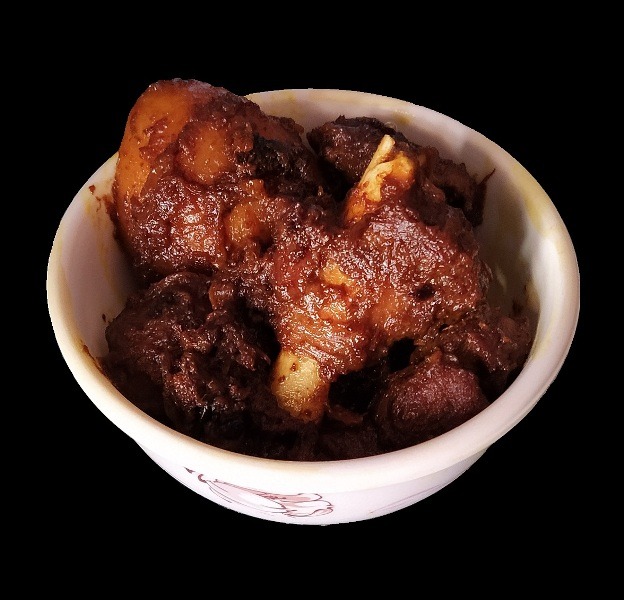
How Much Water Should You Add?
It depends on how you pair up your dish.
If you eat it with simple steamed rice, you would need some amount of dry gravy. So you would need to add some amount of water as the meat cooks. In the below recipe, I have considered this scenario.
However, if you want to eat it with luchi (Bengali style poori made with all purpose flour) or basanti pulao, you may not need any water. At best, a few sprinkles to avoid burning of the onion and spices.
Getting to the Preparations
This dish requires a lot of onions and garlic. I prefer to peel the garlic a night before to save on time.
You can do the same or do all preparations the next morning.
You may also want to soak the dry red chilies overnight. In case you feel lazy the night before or you forget, you can soak them in hot water to help them soften faster before you prepare your paste.
Do not go low on the onions. Onions will add flavor, melt to provide a body to the dry gravy for the mutton kosha.
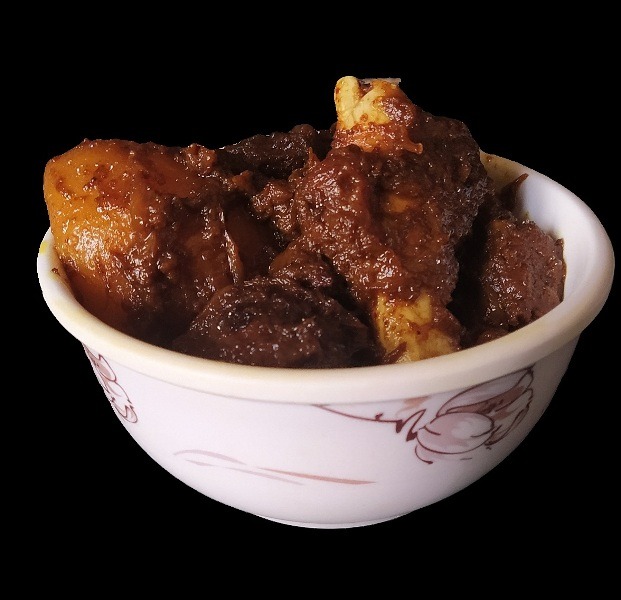
Note
The equipment & ingredient quantity provided in this recipe is to assist you in cooking this dish. Feel free to experiment with your ingredients. Remember that we all have different set, size & shape of kitchen tools in our pantry.
Equipment
- Wok
- Spatula
- Knife & Chopping Board
- Mixie (Mixer-grinder) or mortar and pestle (hamandista in Bengali)
- Preparation & serving bowls
Ingredients
- 1 kg goat meat/mutton medium sized pieces
- 1/2 cup mustard oil
- 2 pc whole red chili
- 1 pc bayleaf
- 1 tsp cumin seeds
- 10 pc medium-sized onions
- 1 tsp turmeric powder
- 1/4 tsp cumin powder optional
- 1/2 tsp coriander powder optional
- 1 cup curd small-sized tea cup
- 1 tsp sugar
- 2 cup hot water keep ready while the meat cooks
- salt to taste
Whole Garam Masala
- 1 tsp whole black pepper
- 2 inch whole cinnamon stick
- 5 pc whole cardamom pods
- 1 pc whole star anise
- 1 pc whole mace optional
Ginger Garlic Chili Paste
- 2 pc garlic pods around 30 cloves of garlic
- 2 inch ginger
- 5 pc green chilies reduce to adjust heat
- 2 pc whole red chili
Instructions
Preparation the Night Before [15 minutes]
- You can very well do this just before you cook, however, I do some preparation the night before. Take two garlic pods and take out around 30 cloves. Peel each of the cloves and put them in the refrigerator. Ensure that you keep them in a packet/bag and seal the opening properly to avoid the raw garlic smell from getting into other edibles
- Take the dried red chilies and soak them in a bowl of water. Leave covered. Soaking them the night before will soften it the next morning for preparing the paste. If you want to do it before cooking, boil water and soak the chilies for around half an hour
Preparation for the Mutton Kosha in the Morning [30 minutes]
- Take 10 pieces of medium sized onions. Peel and slice them. For this recipe, chopping the onions or preparing the paste will not give the best flavors
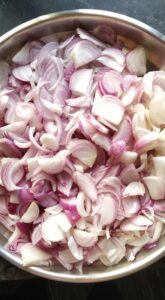
- Take a 2-inch ginger and peel. Chop roughly and add to the mixie
- Chop the garlic cloves and green chilies roughly
- Add the chopped garlic cloves, green chilies and soaked dry red chilies to the mixie
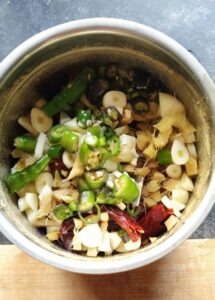
- Prepare a fine paste. If needed you can add a couple of spoons of water

- Peel the potatoes and cut them in halves or quarters, depending on the size. If the potatoes are medium-sized, you can cut them into halves. If large, cut them into quarters
Cooking the Mutton Kosha [2 hours 30 minutes]
- Put a wok on medium heat. Most of the cooking will be done on medium flame
- Add mustard oil and wait till the oil begins to smoke. Never begin cooking in mustard oil before the oil starts to smoke.
- Once you see the smoke, add the dry red chilies and bay leaf
- When the dry red chilies have turned dark brown, add the cumin seeds and allow them to splutter
- Add in the sliced onions. Stir fry till the onions have browned properly. This is one of the most important steps in the entire process, hence make sure that you take your time to brown the onions before moving on to the next step. This can take anywhere between 15 to 20 minutes. Take care to not burn the onions in the process
- Once the onions have browned, add the ginger garlic chilli paste that you prepared previously. Stir fry till the raw smell persists
- Add the mutton pieces
- Drop in the turmeric powder, cumin and coriander powder
- This is where the kosha-ing starts. Increase the flame from medium to high. Continuously stir the mutton along with the onions and spice powders. This helps to char the outer part of the mutton pieces and seals in the juices. Keep doing this for at least 30 minutes
- Lower the flame to medium
- Whisk the curd properly and add to the wok
- Add in the potatoes
- Continuously stir till the curd has blended with the mutton and spices. If you find any curdling, do not worry. It will be fine by the end of the cooking process
- Drop in all the whole spices mentioned under ''Whole Garam Masala'
- Stir well for around two minutes, cook covered for four to five minutes
- Uncover and repeat the above step till the mutton is cooked. If you find the spices sticking to bottom of the wok, use the spatula to recover the spices. Splash in some water after regular intervals to ensure that spices do not stick to the bottom of the wok
- If you wish to serve this mutton kosha with rice, add in a cup of water and allow it to boil. If you wish to serve this with luchi/pulao, do not follow this step
- Add the salt and sugar. Stir and cook covered for a couple of minutes
- Uncover, check for seasonings and adjust if required
- Your kosha mangsho or mutton kosha is ready
- Switch off the flame. Allow the mutton kosha to rest for 15-20 minutes before serving with rice or luchi (poori made of common flour)
Notes
- Get tender mutton cuts. It will help your mutton cook faster. You can ask the butcher to get you the loin and/or rib of the mutton
- Some fat with your mutton always gives an added flavor
- A mutton kosha is best cooked without any water. However, it is fine to use splash in some water to avoid burning of the onions and spices
- To get the best flavors of the mutton, avoid strong spices. I have stuck to whole spices and used very little of cumin and coriander powder. You can avoid the spice powders altogether
- Keep a watchful eye on the wok, you would not want the onions, mutton and spice mix to stick and get burnt
- Tomatoes are not mandatory. The job is done by the curd. You can add tomato when the mutton is 80% cooked. Do not puree a tomato, just dice and add them
- As mentioned previously, slice your onions. Do not dice, chop or make a paste
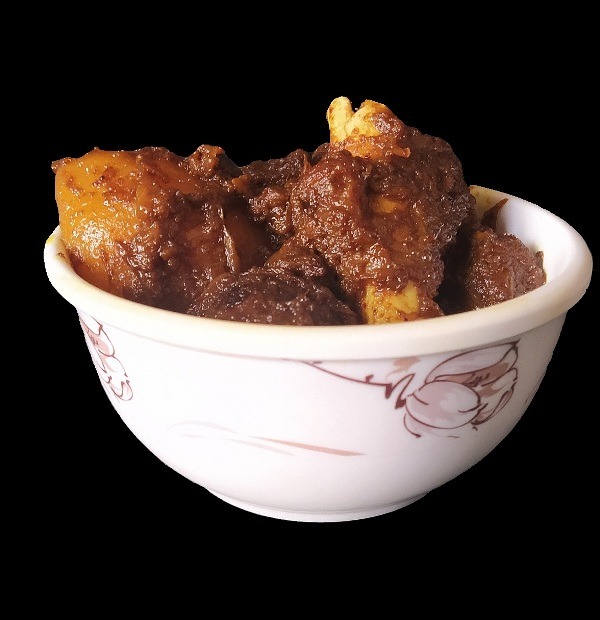

I have no doubt that this is a good recipe. However the weight of onions, ginger and garlic would be more accurate given the size of said ingredients varies dependant on geographical locations.
Yes I agree. However, Indian cooking is not about perfect size and weight of ingredients, it is about ‘andaj’. 🙂 As every recipe states, use your intuition and it would work great, a recipe is a mere guidance to assist you in the kitchen.
Hi Samrat,
Sorry I should have been more specific. Ingredient weights help IF you are interested in reaching the Indian diaspora. People who were not born in India or hung out with ma while she cooked them delicious kosha mangsho have no concept of andaaz and a rough weight gives them a starting point. My two cents!!
your statements about salt and meat are scientifically incorrect. Salt draws out water from plants, but it hydrates proteins.
ভীষন ভাবে বাঙ্গালী পদ্ধতি
Pingback: Dim Kosha Recipe | Bengali Style Spicy, Tangy Egg Recipe
Good instructions I like it.
Very detailed. Liked reading it. Will try it out.
This is so beautifully explained nothing short of poetry. Thank you.